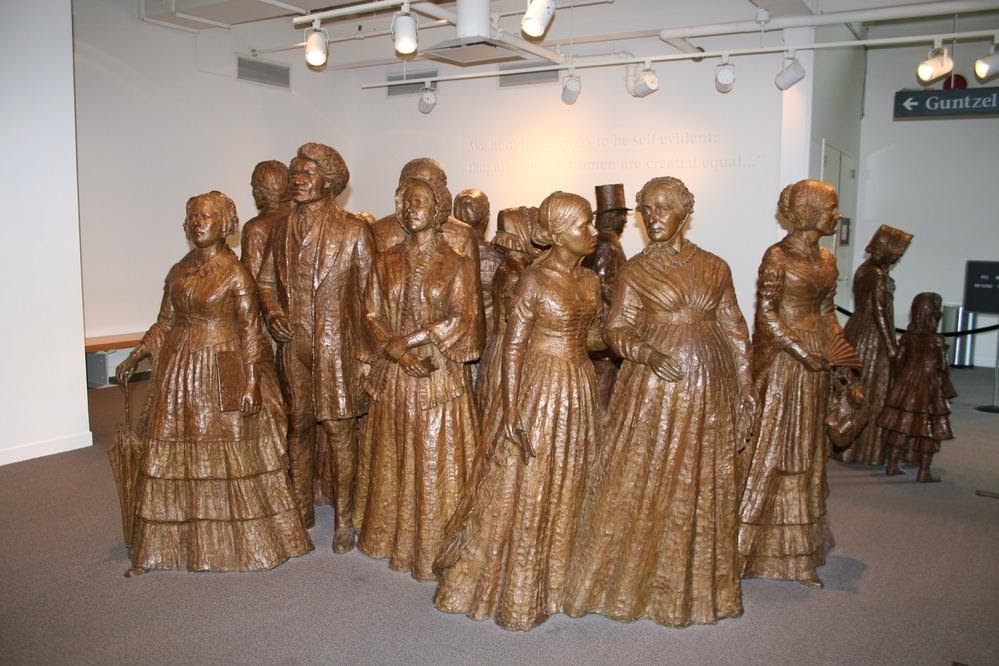A Convention Days Update and Some Fun with Martha Coffin Wright
By: Maria Smith
Hey Everyone!
Today I will discuss Convention Days and provide a vignette about suffragist and convention coordinator, Martha Coffin Wright. Before I begin I’d like to start by acknowledging that all Convention Days events can be found at the WORI Youtube page and the WORI Facebook page. I highly recommend you check it out!
What are Convention Days?
I’m sure that some of you right now are confused and wondering what Convention Days are and why they are celebrated at WORI. Well, the answer is simple, Convention Days celebrates the Anniversary of the 1st Women’s Rights Convention held in Seneca Falls in 1848. The two-day convention was organized in a rush by five women: Lucretia Mott, Jane Hunt, Mary Ann M’Clintock, Mary Coffin Wright, and Elizabeth Cady Stanton, after they had tea at the Hunt home in Waterloo, NY. The five women were all friends of Lucretia Mott, who was in town visiting her sister Martha Coffin Wright. At tea, the women began complaining about their lives and the unequal treatment women faced. They decided to hold a convention to do something other than complain to each other about it. Mott was only in town a few days, and the women wanted her celebrity, as a well-known activist, to gain more publicity. The women then placed a notice in the paper for the convention, which would take place at the Wesleyan Chapel in Seneca Falls.

“The First Wave” Exhibit installed in the Visitor Center of the Women’s Rights National Historical Park in Seneca Falls, NY
Due to schedule conflicts, only Stanton, M’Clintock, and her daughter Elizabeth M’Clintock were able to meet to draft the Declaration of Sentiments. Based on the Declaration of Independence, the Declaration of Sentiments declared that “All men and women were created equal,” which was a radical statement in 1848. Together the women drafted a list of grievances that they held about the treatment of women in the United States. During their preparation for the convention, the women invited their friends. Elizabeth M’Clintock invited Frederick Douglass, who lived in nearby Rochester, NY.

A Letter from Frederick Douglass to Elizabeth M’Clintock accepting her invitation to the 1848 Convention Photo Credit: NPS
About 300 people attended the 1848 convention. The first day was scheduled for women only. When men attended the first day, the women allowed them to sit in the chapel but asked them not to speak. On the second day, men were allowed to participate in the convention. The women did not feel comfortable presiding over a mixed-gendered audience. Instead, James Mott, Lucretia Mott’s husband, presided over the convention. Only one-third (1/3) of attendees signed the Declaration of Sentiments at the end of the convention. Many attendees were nervous about the consequences of signing such a radical document. After the convention, Douglass’s North Star newspaper published a report on the convention for those who could not be in attendance.

Report on the 1848 Convention Published in the North Star
Convention Days 2020
Convention Days provide a space to celebrate the first organized step towards a women’s rights movement. This was the first year that Convention Days was celebrated virtually. Performances and talks were recorded and released on the WORI social media (see the earlier links) and are still available to watch. I was both excited and skeptical of the scheduled historical performances. I think everyone who attends historical sites has at least one story of being disappointed by a bad historic performer. However, the performers that performed for Convention Days were fantastic!
My favorite performance was Dr. Daisy Century’s performance of Harriet Tubman. Century talked about Tubman’s childhood as an enslaved girl, which is rarely portrayed in historical performances. Another wonderful performance was titled “The Bounds of Friendship: A Living History Dialogue.” In that performance, a Frederick Douglass performer and an Elizabeth Cady Stanton performer discuss their tense friendship. Stanton was an abolitionist, but she was also racist. “Bounds of Friendship” directly engages with the tension that existed in their friendship between a Black man and a White woman in the mid-1800s.
I would also highly recommend Dr. Laura Free’s Talk “Grappling with Suffragists Racism.” During her talk Free directly confronts the racist language used by White suffragists to further the cause of women’s suffrage. After the Civil War, women and Black men wanted the right to vote. Some women’s suffragists and Black suffragists worked towards universal suffrage. Stanton tried to leverage her Whiteness to earn White women’s suffrage before Black suffrage. Her plan was ultimately unsuccessful. The 15th amendment provided the right to vote for Black men in 1870. The 19th amendment provided the right to vote for women in 1920.
A Vignette (Short Story) About Martha Coffin Wright
Martha Coffin Wright was the younger sister of Lucretia Coffin Mott. Wright was living in Auburn, NY with her husband and children in 1848. Wright was a bit of an eccentric. She had a pet flying squirrel in her home. In a time when domestic activities were gendered, Wright taught her sons to sew and knit. Wright kept pamphlets near her door about the causes that she supported. When a missionary came to her door to teach her about their religion, Wright would only let them in if they would listen to her teach them about her cause. However, Wright is most well-known for her strong beliefs and her humor.

Martha Coffin Wright with her daughter Eliza Photo Credit: NPS

Martha Coffin Wright Photo Credit: Library of Congress
Wright wrote satirical articles in response to events and articles that she read in the newspaper. One time, Wright read an article written by a man that provided tips for wives to make their husbands happy. One tip was that wives smile more. Angry at the author’s blatant sexism, Wright wrote a satirical article titled “Hints for Wives.” Wright ends the article by saying that husbands should take the advice given to their wives. This article was read by Lucretia Mott at the 1848 convention. The article was such a hit that it was republished by Frederick Douglass in the North Star after the convention.

